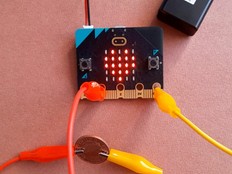第 1 步:制作
它是什么?
将您的 BBC micro:bit 变成测量温度、亮度和音量水平的工具,作为对您环境进行科学调查的一部分。
介绍
编程指南
如何使用
- 通过这个项目,将您的micro:bit变成一个温度计,音量计和亮度计,用来在科学实验中进行环境测量。
- 将下面的代码上传到您的micro:bit,或者跟随视频自己完成代码的编写。
- 将电池组连接上你的micro:bit,就可以开始使用了。
- 您可以使用我们的数据录制表来记录您的测量到的值。
温度
使用 micro:bit 作为温度计来测量不同地方的温度差异。 按下按钮A,让显示屏显示现在温度是多少摄氏度。 测量一个新地方的温度前,建议先把放micro:bit在这里几分钟,这样好测得这地方精准的温度,
声音
要将micro:bit作为音量计使用时,按下按钮B,以0(最小声)到255(最大声)来表示当前环境下声音有多大。
在测量音量前会有一个短暂的延迟,从而避免把我们按下按钮的声音被误录下来。
光线
要将micro:bit用作亮度计,同时按下按钮A和按钮B。 它会以0(最暗)到255(最亮)来显示当前的环境亮度。
分析您的数据
重要提示:收集尽可能多的数据是良好的科学做法,为此您应在每个地方测量不止一次,并按照地点不同计算平均值。
当您记录好了数据,你就通过分析这些数据来得出结论。 从周围环境中的温度、音量和亮度数据中,您可以发现什么?
比如说,您周围环境中最暖和、最冷、最吵闹、最安静、最亮堂和最阴暗的地方都是哪里?可能是什么因素导致的?
所需材料
- micro:bit
- MakeCode 或者 Python 编辑器
- 电池盒
- 数据记录表,或者任意的写字纸
- 墨水笔或铅笔
数据记录表
用下面的数据记录表来记录您每次测量得到的值。

第 2 步:编程
1from microbit import *
2
3# The Python version of this project has sleep()
4# for each button press to make the A+B button work better
5
6while True:
7 if button_a.is_pressed() and button_b.is_pressed():
8 display.scroll(display.read_light_level())
9 sleep(200)
10 elif button_a.is_pressed():
11 display.scroll(temperature())
12 sleep(200)
13 elif button_b.is_pressed():
14 sleep(200)
15 display.scroll(microphone.sound_level())第3步:完善
- 在程序中增加代码块show string,让温度、音量和亮度在显示时更好读懂。
- 参考华氏温度计项目来修改您的代码,从而让温度按华氏度显示。
- 假如您的micro:bit是不带麦克风的V1版本,您可以移除按下按钮B测量音量的代码,只保留温度和亮度的测量能力。
This content is published under a Creative Commons Attribution-ShareAlike 4.0 International (CC BY-SA 4.0) licence.


